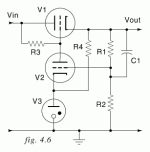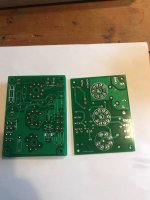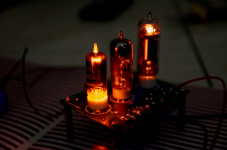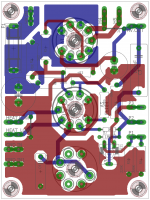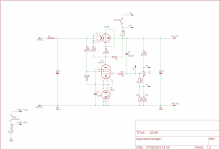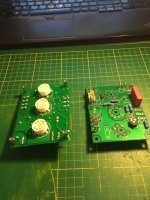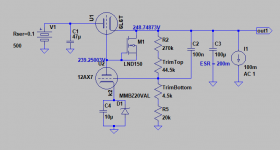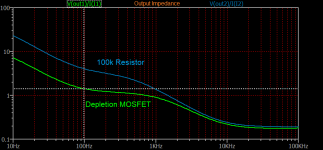hi,
I'm trying this power tube regulator using a 6l6 tube and 12ax7 triode, I'm planning to use this power supply in my tube preamp.
It's working so far and I'm quite happy with the sound but I'm wondering if anything else could be done to it to improve the design???
please have a look and comment.
best.

I'm trying this power tube regulator using a 6l6 tube and 12ax7 triode, I'm planning to use this power supply in my tube preamp.
It's working so far and I'm quite happy with the sound but I'm wondering if anything else could be done to it to improve the design???
please have a look and comment.
best.
The 20V Zener may need a bit more current to work well, than the plate current of the 12AX7.
Use no more than a 400mW Zener.
Use no more than a 400mW Zener.
Last edited:
thanx for your comment,
I'm using 1n4745a (16v) at the moment, the only zener that I had around, .... works quite well.
I'm using 1n4745a (16v) at the moment, the only zener that I had around, .... works quite well.
I'd up the voltage and downsize the power, so the current is in a more comfortable range
for the Zener. A current less than 5% of Pz/Vz would be in a bad place.
So 1W/16V = 62mA (then want > 3.2mA in Zener) is more than 0.4W/20V = 20mA (then want > 1mA in Zener),
which will just make the cut with the plate current for a 12AX7.
for the Zener. A current less than 5% of Pz/Vz would be in a bad place.
So 1W/16V = 62mA (then want > 3.2mA in Zener) is more than 0.4W/20V = 20mA (then want > 1mA in Zener),
which will just make the cut with the plate current for a 12AX7.
I will do!, Thank you 🙂I'd up the voltage and downsize the power, so the current is in a more comfortable range
for the Zener. A current less than 5% of Pz/Vz would be in a bad place.
So 1W/16V = 62mA (then want > 3.2mA in Zener) is more than 0.4W/20V = 20mA (then want > 1mA in Zener),
which will just make the cut with the plate current for a 12AX7.
Thanx, It's a good but not so detailed explanation, but what got my attention is to replace the Zener with a tube regulator, I think I have 75c1 somewhere around, and according to John's explanation, I will need to add a resistor between 6L6 cathode output and ECC83 cathode where it will meet 75c1 regulator tube to put the regulator into a stable operation region, on John's example this resistor is marked R4, how to calculate the value of this resistor?
Attachments
hi, i will try it, but have zero hum atm.Try using the 12AX7 as cascode, feeding the upper grid from input side of the reg. Great advantages can be found. I made many times this configuration with great benefits from hum rejecting.
yeah!, that's probably a good point and i was thinking about it already 🙂Or use a dirt cheap pentode like EF80, EF184 instead of a comparably expensive 12AX7 half.
Best regards!
The PSRR is not hugely affected by the input capacitor. While you have it soldered in place, 330uF is well past the value of diminishing returns. Here's a simulation of PSRR with the output capacitor stepped at the values shown, and the input cap set at 47uF. (The output cap for the simulation is shown without ESR, if you assume 200 milli Ohms, the curve flattens.)
You might want to put an RC filter on the zener to tame noise.
You might want to put an RC filter on the zener to tame noise.
Attachments
Last edited:
great!, so the bigger the output cap the better, ,,,and a small cap across the zener to filter the zener's noise !, thanx for that.
Here is a board i made for a tube regulator.
To answer your question: 0B2 for the reference and replace the 100K resistor with a DN2540 or 10M45S current source set at approx
Kay made a good point, EF184 is a supertube for this application if you current source load it with approx 5mA its gain and hence noise rejection skyrockets. One added benefit is that the reference current is also fixed by the application of a constant current.
To answer your question: 0B2 for the reference and replace the 100K resistor with a DN2540 or 10M45S current source set at approx
Kay made a good point, EF184 is a supertube for this application if you current source load it with approx 5mA its gain and hence noise rejection skyrockets. One added benefit is that the reference current is also fixed by the application of a constant current.
Attachments
 Please do not quote the entire post just above yours. Keep the forum clean!
Please do not quote the entire post just above yours. Keep the forum clean!Extraneous quotes have been removed.
You can use an LND150 which has Idss of ~2mA and 9V across it well within the safe-operating-area. Output impedance will be better as well.To answer your question: <SNIP> replace the 100K resistor with a DN2540 or 10M45S current source set at approx
Attachments
Last edited:
If you can handle the topcap a EL36/EL360 pass tube or E235L(pin compatible with 6L6 i think) will do much better in therms of load regulation and has much lower Ri in triode, abeit at a lower mu then 6L6. So to compensate you could try EF184.
One of the nice things about the EF184 is that it has a heater cathode isolation value of 250V so its possible to use a 108V reference tube 0B2
/SG2P/108C1 ect. And tie the heater to the 6L6 heater which is tied to the output.
One of the nice things about the EF184 is that it has a heater cathode isolation value of 250V so its possible to use a 108V reference tube 0B2
/SG2P/108C1 ect. And tie the heater to the 6L6 heater which is tied to the output.
- Home
- Amplifiers
- Power Supplies
- tube power regulator
